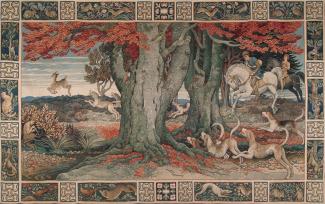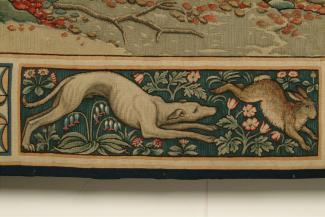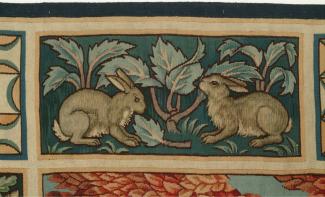One of the greatest tapestries ever inspired by the New Forest is 'The Chace' designed by Heywood Sumner and woven at Morris & Co. by Martin, Taylor, Glassbrook & Berry at Merton Abbey in 1908.
George Heywood Maunoir Sumner worked, honeymooned and finally built his ideal home in the New Forest where he then settled for life, from 1904, and began work on his book “Cuckoo Hill, the Book of Gorley”. The book was still in progress when he was commissioned by Henry Currie Marillier in 1908, as one of a group of Arts and Crafts artists in the circle of William Morris, to design a large scale piece to be woven by the tapestry works at Merton Abbey. So Heywood Sumner drew up the design for the central scene of The Chace1, in the form of a watercolour, pen and ink cartoon.
In this commission Heywood Sumner clearly seized the chance to combine his deepening love of the Forest with his growing passion for the past. Gorley was for him “this beautiful place… Our days here begin over the Forest, and end behind the Chase. Eastward… lies the New Forest. Westward… rise the long ridges of Cranborne Chase”. Heywood Sumner took immense visual and sensual pleasure in observing the seasonal changes in the Nova Foresta, revelling in the variety of colours and forms in the spacious landscapes around him, and embracing nature in all her myriad moods, from spring larks and dry bournes, to windswept heaths and wild winters. The New Forest, ‘an ancient and ornamental woods’, was the perfect backdrop for the stylised medieval hunting scene that he devised, which married his keen observation of nature with his skill for illustrative storytelling.
Later, in his book A Guide to the New Forest of 1924 Heywood Sumner was to describe two beeches at Mark Ash with enormous girths of over 18 and 20 feet at four feet above ground level, one dividing into six vertical stems at 10 feet above the ground. He clearly revered the antiquity of these beeches and their surroundings: “mystery amid a great company of trees abides here”. It seems fairly clear that these beech trees at Mark Ash had been his inspiration for the trees we see in the foreground of The Chace. The roots of the trees in the tapestry have clear echoes in the engraving accompanying his description of the trees at Mark Ash, and there are even a couple of artfully placed twigs of remarkably similar design in the foreground.
Medieval hunting estates in the time of Kings William, Rufus and John abounded in the New Forest, from Beaulieu to Cranborne Chase. ‘Hunting with the hounds’ was one of Heywood Sumner’s stock in phrases, and the idea of depicting a centuries’ old forest tradition must have appealed to his immense pride of place. The main scene of ‘The Chace’ tapestry is both highly animated, and richly evocative of a romantic past. The hounds are in pursuit of a young fallow deer, leaping high, in an image that anticipates what would become an enduring motif of the Art Deco period, and even that iconic Disney ‘prince of the forest’, Bambi (1942). Medieval style dress gives the horse riders a quasi Arthurian character.
There is an almost audible sense of myriad sounds, from the chattering brook, the horns and pipe, panting dogs, the click of stirrups and the clack of hooves, to the winds coursing across from the west, whistling through the beech leaves. The depth of perspective created is remarkable: the hounds and horses converging towards the deer, lead our eyes diagonally across, and then where he hounds leap the brook we are lead along its path to Pan - satyr god of fields and woods, personification of natural forces and instincts - half hidden beside the sand and gravel, and then we are led through beeches, and past fir, to bracken and wooded valleys, and on “across miles of rugged heathland” to “hills that fade into dim blue distance”, under skies of cirrus stratus clouds. This is a typical verdure tapestry in the sense of substantially displaying landscape views, and yet it has a far richer and more subtle tonality, not predominantly green but rather a bold palette of rich autumn colours.
The Art Journal of 1900 commented that “Mr Heywood Sumner represents a school which puts nature, if anything, before ornament”. It is the border that is most typically William Morris in style, offering delightful geometric vignettes showing birds and animals in a sinewy continuum. Pheasants, fox and hound, rabbits, green woodpeckers, wildcat, and partridges are all involved in their daily business of grazing and climbing and chasing and playing, amongst flowers, fungi, oak leaves and acorns, and given the typical Merton Abbey stylisation.
Provenance
Shown at Morris & Co, 1909; The Arts and Crafts Exhibition Society, 1910, no 372; Palasi du Louvre, Paris 1914. It was then bought by Mr J Fleming, of Aldwick Grange, Bognor, founder of the Fleming restaurants. It was sold at Sotheby’s Belgravia, 7 June 1972 to the Littlecote Gallery, where it remained until May 1978 when it was acquired by Hampshire Museums Service. It has been variously loaned for exhibition at Birmingham Museums and Art Gallery 1981; Portsmouth, Cheltenham, Winchester Gallery 1986; and Lymington, St Barbe Museum 2000 and 2007.
1 In the archaic use of the word ‘chace’ which can mean huntsman, there are echoes of the infamous Poems of Ossian by James MacPherson (1760):
“My love is a son of the hill
He pursues the flying deer
his grey dogs are panting around him…
by the stream where the rushes are
nodding in the wind…
Lovely I saw thee…
thou wert returning tall from the chace”.
Purchased with the assistance of the V&A Purchase Grant Fund







